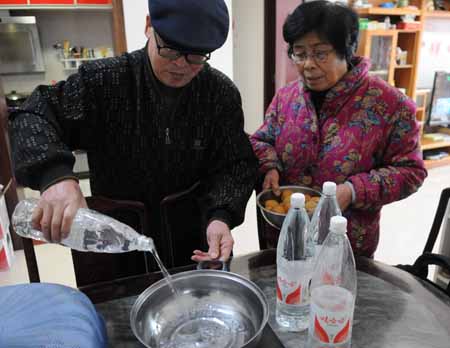Tapping into safer water access
Updated: 2012-05-24 10:07
By Wu Wencong and Zheng Jinran (China Daily)
|
||||||||
|
 |
|
Wei Shubing (left) and his wife must use bottled water for cooking after Longjiang River was contaminated by cadmium in January, affecting residents of Liuzhou city in the Guangxi Zhuang autonomous region. [Photo/China Daily] |
Source water quality
The safety of tap water is dependent on many factors, the most important being the quality of source water, according to experts. The latest figure, released by the Ministry of Water Resources, said 80 percent is safe nationally. But Century Weekly quoted Song Lanhe, another official from the ministry's monitoring center, as saying that the rate is actually closer to 50 percent.
"Much of China's source water is now surrounded by residential buildings, especially farms," said Tsinghua University's Fu. "The increase in annual agricultural output is supported by the use of huge amounts of chemicals and fertilizers, which will definitely enter the water table and contaminate our source water."
Meanwhile, sewage dumped into rivers by chemical plants has also played a major role in changing the main pollutants from micro-organisms to organic compounds and heavy metals, many of which are toxic. "The facilities and equipment currently used in water plants were able to remove source-water pollutants efficiently before the 1980s, but they can't deal with those we face now," said Li.
The nation's antiquated pipeline network is another thorn in the side of those seeking to improve the quality of the water supply. Statistics released by the China Institute of Water Resources and Hydropower Research suggest that approximately 6 percent of the pipes have been in use for more than 50 years. "The water quality decreases by about 10 percent during this (delivery) process," said Wang Hao, head of the water resources department at the institute, according to a recent report from the Xinhua News Agency.
"The levels of bacteria in the pipes increase tenfold every decade. Some corrosive substances in the pipes may also be absorbed by the water," said Zhao Feihong, a researcher at the Beijing Institute of Public Health and Drinking Water. Projects to replace the older pipes are currently ongoing nationwide, but China's vast landmass means the situation will take a long time to rectify.
Other dangers lurk unseen too: To guarantee adequate water pressure, buildings higher than six stories usually utilize a holding tank on the top floor. The system, known as 'gravity feeding" works well, but can become a health hazard if not carefully maintained. "These water tanks usually lack a regular sanitation management regime and are often loosely sealed," commented Lan Weiguang. "Green moss, bacteria and even the bodies of small animals are often found in them."
Low levels of funding
According to insiders from the Ministry of Housing and Urban-Rural Development, the fundamental problem in maintaining water quality is the low level of funding. "Investment is far from sufficient in this sector," they said.
Those insiders received support from a number of experts. The problems inherent in the treatment process, the pipes and water tanks can be solved with the existing technology, they said, but there simply isn't enough money invested in the system to provide that technology.
That problem is compounded by the fact that even raising the water quality indicator by one level results in spiraling treatment costs. Industry insiders told Xinhua that testing all 106 indicators in one sample costs 15,000 to 20,000 yuan ($2,370 to $3,160). However, as all of the indicators must be tested at least once a year, and others on a monthly or weekly basis, that sort of money is beyond most cities at present.
Contact the reporters at wuwencong@chinadaily.com.cn or zhengjinran@chinadaily.com.cn

 Relief reaches isolated village
Relief reaches isolated village
 Rainfall poses new threats to quake-hit region
Rainfall poses new threats to quake-hit region
 Funerals begin for Boston bombing victims
Funerals begin for Boston bombing victims
 Quake takeaway from China's Air Force
Quake takeaway from China's Air Force
 Obama celebrates young inventors at science fair
Obama celebrates young inventors at science fair
 Earth Day marked around the world
Earth Day marked around the world
 Volunteer team helping students find sense of normalcy
Volunteer team helping students find sense of normalcy
 Ethnic groups quick to join rescue efforts
Ethnic groups quick to join rescue efforts
Most Viewed
Editor's Picks

|

|

|

|

|

|
Today's Top News
Health new priority for quake zone
Xi meets US top military officer
Japan's boats driven out of Diaoyu
China mulls online shopping legislation
Bird flu death toll rises to 22
Putin appoints new ambassador to China
Japanese ships blocked from Diaoyu Islands
Inspired by Guan, more Chinese pick up golf
US Weekly

|

|






